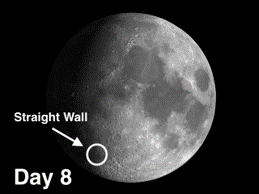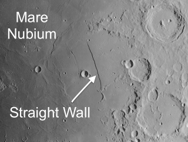The week of March 2-8 takes us from Lunar Day 7 to Day 14, This week we will highlight the lunar fault Straight Wall, visible on Days 7 & 8.
 Straight Wall: (Rupes Recta): [SW/M9] Two of the best-known faults on the Moon are Rupes Recta and Rupes Cauchy [Day 4]. They are fascinating to explore and they share remarkably similar neighborhoods: Both features are paralleled by a nearby rille, and in each case, an intervening small crater separates the rille and the fault.
Straight Wall: (Rupes Recta): [SW/M9] Two of the best-known faults on the Moon are Rupes Recta and Rupes Cauchy [Day 4]. They are fascinating to explore and they share remarkably similar neighborhoods: Both features are paralleled by a nearby rille, and in each case, an intervening small crater separates the rille and the fault.
 Straight Wall is the showpiece lunar fault line and can be seen clearly in the smallest telescopes. It is 70 miles long and 1,300 feet high. If you view it either in the early morning on Day 7, or at lunar sunset around Day 22, you will see clear evidence that Straight Wall is an enormous fault line where the terrain to its west has fallen away. In the morning, the rising sun casts a thick black shadow over the lava plain to the west. At sunset two weeks later, the exposed slope of the fault is brightly illuminated.
Straight Wall is the showpiece lunar fault line and can be seen clearly in the smallest telescopes. It is 70 miles long and 1,300 feet high. If you view it either in the early morning on Day 7, or at lunar sunset around Day 22, you will see clear evidence that Straight Wall is an enormous fault line where the terrain to its west has fallen away. In the morning, the rising sun casts a thick black shadow over the lava plain to the west. At sunset two weeks later, the exposed slope of the fault is brightly illuminated.
At its south end, Straight Wall terminates in what looks like a small arc of mountains. The effect of the ensemble makes Straight Wall look remarkably like a sword with handle and hilt. This arc of mountains is actually the remains of an ancient unnamed crater whose western side, like Straight Wall itself, dropped as a result of faulting. When lava-flows later flooded Mare Nubium they also covered the slumped western portion of this crater.
OF ADDITIONAL INTEREST IN SPACE:
Not a favorite event for astronomers: daylight savings begins on Sunday, March 8.
Here’s an interesting project to do for your child:
I covered my grandson’s bedroom ceiling with glow-in-the-dark constellations. I got push-pins from Amazon, both in the shape of stars1 and little globes 2. I painted them with phosphorescent paint3 and connected them together in their constellations with glow-in-the-dark string that I found on Amazon4. It worked better than I thought and my grandson can now go to sleep gazing up at the night sky. (See below photo for the constellation Pegasus, the flying horse (it’s upside down in the sky, but looks more-or-less like a horse). If you’re not completely secure with the constellation names, you can get a label maker from Amazon and use non-phosphorescent push pins to attach them, then learn them during the day or when you have the lights on.
1 Go to Amazon and search for Clear Star Push Pins
2 Search for Map Tacks Push Pins, 1/5-inch Round Head and Push Pins Map Tacks 1/8-inch round head white
3 Search for DecoArt DS50-10 Glow-in-The-Dark Paint
4 Search for “Glow In The Dark Micro Cord”
======================
It is highly recommended that you get a copy of Sky and Telescope’s Field Map of the Moon, the very finest Moon map available for use at the telescope. It is available for $10.95 at www.skyandtelescope.com and on Amazon. All features mentioned in this blog will be keyed to the grid on the Field Map and will look like this: Plato: [NW/D9]
Credits:
Courtesy of Gray Photography of Corpus Christi, Texas
Lunar photos: NASA / USGS / BMDO / LROC / ASU / DLR / LOLA / Moon Globe. Used by permission
- Rupes Cauchy: A Best Known Fault on the Moon - July 22, 2024
- Moon Crater Schickard – Crater Floor has Stripes - July 15, 2024
- Moon Craters Langrenus and Vandelinus - July 8, 2024
